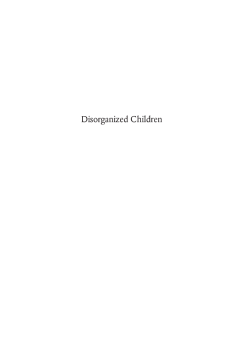
Additional Information
Book Details
Abstract
Disorganized children' may display a range of behaviours symptomatic of, for example, ADHD, autism and conduct disorders, but they often fail to meet all the criteria for a clear diagnosis.
In this book, psychiatrists, speech, family and occupational therapists and neurodevelopment specialists present a range of behavioural and psychological strategies to help disorganized children improve concentration and performance in the classroom and deal with a variety of behaviour and social interaction difficulties. The authors also provide information and interventions for dyslexia, dyspraxia, OCD and schizophrenia, among others.
The combination of information, exercises and case studies makes this a valuable tool for use by parents, health care and teaching professionals, and the authors provide an insight into the mind of disorganized children and practical guidance on how best to help them achieve their full potential.
There are chapters on cognitive functions; abstraction and symbolisation; theory of mind; attachment; and a wide range or disorders such as ADHD, autism, dyslexia, epilepsy, minimal brain dysfunction, obsessive compulsive disorders, schizophrenia, and tic and Tourette syndrome.' (The symptoms of these disorders are listed clearly for parents and professionals, with case studies.) There are also chapters on child psychiatry, clinical psychology, child psychotherapy, the classroom, family therapy, occupational and group therapy.
YoungMinds Magazine
This book focuses on multi-disciplinary approaches that address the difficulties faced by disorganised children. It provides an insight into the symptoms of these children and guidance on how to help them reach their full potential.
YoungMinds Magazine
This book, edited by consultants experienced in child, adolescent and family psychiatry, is aimed at parents, healthcare and teaching professionals to gain insight and practical guidance from the information, exercises and case studies within to use as a tool to best help disorganized children.
The National Child-minding Asssociation
This is an excellent book, highly-recommended for those wanting to develop their knowledge and understanding of neuro-developmental conditions and how they can affect individuals.
Dyslexia Contact
There is no doubt that its strength lies in the fact that it contains a wealth of valuable information.
YoungMinds Magazine
Table of Contents
| Section Title | Page | Action | Price |
|---|---|---|---|
| Preface and Acknowledgements | |||
| 1. Understanding Vulnerabhty - an Introduction | |||
| JOHN TWIGG | |||
| 2. Women Victims' View of Urban and Rural Vulnerability | |||
| ELA R. BHATT | |||
| 3. Drought and Household Coping Strategies among Peasant | |||
| Communities in the Dry Zone of Sri Lanka | |||
| R.B. SENAKA ARACHCHI | |||
| 4. Coping with Climatic Disasters in Isolated Hdl | |||
| Communities of Nepal: the Case of Rampur | |||
| Village in Okhaldhunga | |||
| NGAMINDRA DAHAL | |||
| 5. Can Vulnerability be Understood? | |||
| MIHIR R. BHATT | |||
| References | |||
| Biographical Details of Contributors | |||
| Other Duryog Nivaran Publications on Disasters and | |||
| Vulnerabihty |
